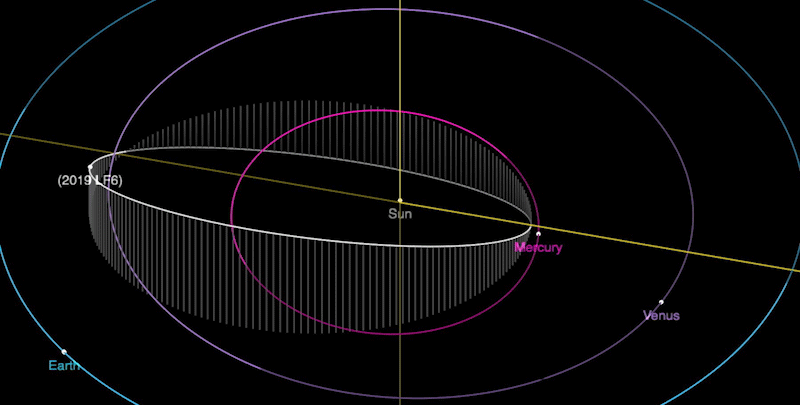How This Huge, Superfast Asteroid Stayed Hidden in Near-Earth Orbit

The year goes by quickly for this newfound asteroid. The so-called 2019 LF6 asteroid circles the sun every 151 days, the shortest orbit of any known asteroid.
This swift-moving rock snuggles closer to the sun than does our planet, which takes 365 days to make the solar trek. LF6 is one of 20 others, collectively called Atira asteroids, that move within a cosmic hug of our planet, according to a statement from the California Institute of Technology.
Although this meteor is quite large — around 0.6 miles (1 kilometer) across — it had remained hidden from astronomers' prying eyes until now. "LF6 is very unusual both in orbit and in size — its unique orbit explains why such a large asteroid eluded several decades of careful searches," Quanzhi Ye, a postdoctoral student at Caltech, said in the statement.
The asteroid's elliptical orbit brings the space rock well outside of the plane on which the planets of our solar system orbit, and it gets closer than Mercury does to the sun. (Mercury is the sun's nearest planetary neighbor.) This asteroid could have been slingshot out of the plane when it came too close to the gravitational disturbances of Venus or Mercury, according to the statement. [10 Interesting Places in the Solar System We'd Like to Visit]
Ye discovered the chunk of rock using Palomar Observatory's Zwicky Transient Facility (ZTF), a camera that rapidly scans the night sky searching for signals from exploding or flashing stars and moving asteroids.
But Ye and his team have a short window every night to detect these objects. Because they're so close to the sun, the best time to find them is around 20 to 30 minutes before sunrise or after sunset.
Previously, the same team, in collaboration with others as part of an observing campaign called Twilight, discovered another asteroid using this system. That asteroid also turned out to orbit the sun outside of the solar system's plane. Called 2019 AQ3, that space rock circled the sun every 165 days and held the title for shortest asteroid year, until now.
Sign up for the Live Science daily newsletter now
Get the world’s most fascinating discoveries delivered straight to your inbox.
Finding an asteroid this large is quite rare. "You don't find kilometer-size asteroids very often these days," Ye said. "Thirty years ago, people started organizing methodical asteroid searches, finding larger objects first, but now that most of them have been found, the bigger ones are rare birds."
- Death by Asteroid: The Most Likely Ways for a Space Rock to Kill You
- Watch 3 Solar Eclipses on Mars, Captured by Curiosity
- Way to Be Weird, Earth: 10 Strange Findings About Our Planet in 2018
Originally published on Live Science.

Yasemin is a staff writer at Live Science, covering health, neuroscience and biology. Her work has appeared in Scientific American, Science and the San Jose Mercury News. She has a bachelor's degree in biomedical engineering from the University of Connecticut and a graduate certificate in science communication from the University of California, Santa Cruz.










